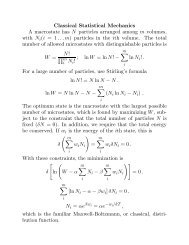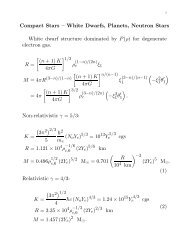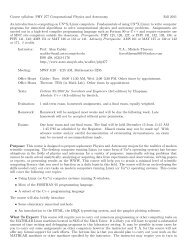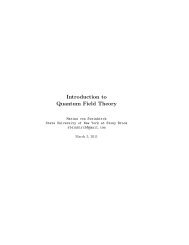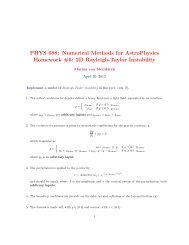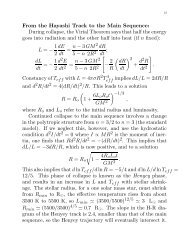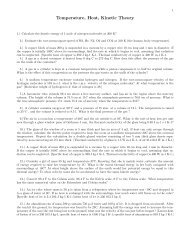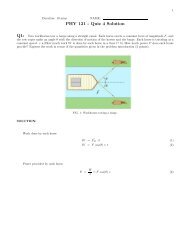You also want an ePaper? Increase the reach of your titles
YUMPU automatically turns print PDFs into web optimized ePapers that Google loves.
2<br />
In dimensionless coordinates ¯x = x/a, ȳ = y/a, m 1 = M 1 /M, m 2 = M 2 /M:<br />
⎡<br />
⎤<br />
−Φ(¯x,ȳ) = GM ⎢ m 1<br />
m<br />
⎣<br />
+ √ 2<br />
+<br />
a<br />
√(¯x 1 (<br />
¯x 2 + ȳ 2) ⎥<br />
⎦.<br />
− m 2 ) 2 + ȳ 2 (¯x + m 1 ) 2 + ȳ 2 2<br />
Contours of constant Φ are shown in the figure. There are deep minima at<br />
the stellar centers, and maxima at five so-called Lagrangian points. The L 1<br />
point between the stars is significant because if a star expands and reaches<br />
the potential surface passing through it, mass can be transferred to its<br />
companion.<br />
The equipotential surface that passes through L 1 is called the Roche<br />
lobe, and its size depends upon the mass ratio of the binary. Kopal (1959)<br />
gives for the radius R R with nearly the same volume as the Roche lobe:<br />
( )<br />
R 1/3<br />
R M1<br />
a = 0.46 . (1)<br />
M<br />
A better fit is by Eggleton:<br />
[<br />
R R /a = 0.49<br />
.6 +<br />
(<br />
M1<br />
M 2<br />
) −2/3<br />
ln<br />
(<br />
1 +<br />
(<br />
M1<br />
M 2<br />
) 1/3<br />
)] −1<br />
. (2)



